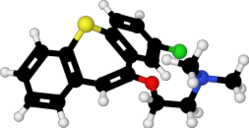Top Qs
Timeline
Chat
Perspective
Zotepine
Atypical antipsychotic medication From Wikipedia, the free encyclopedia
Remove ads
Zotepine is an atypical antipsychotic drug indicated for acute and chronic schizophrenia. It has been used in Germany since 1990 (although it has been discontinued in Germany) and Japan since 1982.
Zotepine is not approved for use in the United States, United Kingdom, Australia, Canada or New Zealand.[3]
Remove ads
Medical uses
Zotepine's primary use is as a treatment for schizophrenia[4] although clinical trials have been conducted (with positive results) into its efficacy as an antimanic agent in patients with acute bipolar mania.[5][6][7] In a 2013 study in a comparison of 15 antipsychotic drugs in effectivity in treating schizophrenic symptoms, zotepine demonstrated medium-strong effectivity. Less effective than clozapine, slightly less effective than olanzapine and risperidone, approximately as effective as paliperidone, and slightly more effective than haloperidol, quetiapine, and aripiprazole.[8]
Remove ads
Side effects
- Tachycardia
- Hypotension
- Orthostatic hypotension
- Palpitations
- Hyperprolactinaemia
- Weight gain (produces a similar degree of weight gain to that seen with clozapine and olanzapine treatment)[9]
- Somnolence (2nd highest effect size for causing sedation out of fifteen antipsychotics compared in a recent meta-analysis)[9]
- Extrapyramidal side effects [EPSE] (2nd largest odds ratio for causing EPSE out of fifteen antipsychotics compared in a recent meta-analysis, second only to haloperidol)[9]
- Constipation
- Xerostomia (dry mouth)
- Blurred vision
- Hypersalivation (drooling)
- Mydriasis
- Anxiety
- Agitation
- Rhinitis
- Sexual dysfunction
- Dyspnoea
- Diarrhoea
- Influenza-like symptoms
- Cough
- Vertigo
- Confusion
- Dyspepsia
- Flushing dry skin
- Arthralgia
- Myalgia
- Acne
- Conjunctivitis
- Thrombocythaemia
- QT interval prolongation
- Hyperthermia
- Hypothermia
- Increased serum creatinine
- Hyperglycaemia
- Hypoglycaemia
- Hyperlipidaemia
- Thirst
- Urinary incontinence
- Angle-closure glaucoma
- Agranulocytosis
- Neutropaenia
- Eosinophilia
- Leukocytopenia
- Hypoesthesia
- Anaemia
- Myoclonus
- Myasthenia
- Alopecia
- Thrombocytopaenia
- Bradycardia
- Epistaxis
- Abdominal enlargement
- Deep vein thrombosis
- Paralytic ileus
- Leukopenia
- Tardive dyskinesia
- Neuroleptic malignant syndrome
- Laryngeal edema
- Urinary retention
- Depression
- Ataxia
- Amnesia
- Seizure (dose-dependent risk)[3]
- Metabolic syndrome
- Diabetes mellitus type II
- Cholestasis
- Increased liver enzymes
- Photosensitivity
- Exanthema
- Pruritus
- Hypouricemia
- Oedema
Remove ads
Pharmacology
Pharmacodynamics
The antipsychotic effect of zotepine is thought to be mediated through antagonist activity at dopamine and serotonin receptors. Zotepine has a high affinity for the D1 and D2 receptors. It also affects the 5-HT2A, 5-HT2C, 5-HT6, and 5-HT7 receptors.[10] In addition, its active metabolite, norzotepine, serves as a potent norepinephrine reuptake inhibitor.[11]
Synthesis
The reaction of 2-chloroacetophenone with 4-chlorothiophenol gives a thioether. This is treated with morpholine and sulfur in a Willgerodt–Kindler reaction to give a phenylacetic acid derivative after acid hydrolysis of the amide intermediate. Cyclization of this compound in the presence of polyphosphoric acid forms the dibenzothiepin ring system of the drug. The enol ether, zotepine, is produced when this is treated with the chloroethyl amine and potassium carbonate in methyl isobutyl ketone as solvent. Under these conditions, the undesired product of C-alkylation is minimised.[12][13][14]
Remove ads
Society and culture
Brand names
Brand names include Losizopilon (JP), Lodopin (ID, JP), Nipolept (DE†), Setous (JP), Zoleptil (CZ, PT, TR, UK†), Zotewin (IN); where † indicates a formulation that has been discontinued.
See also
- Carbinoxamine, diphenhydramine, doxylamine, orphenadrine — the termination chain is the same
- Clotiapine - the base is similar
- Noxiptyline - the termination chain is similar
- Toll-like receptor 4 — investigating probable antagonistic (antiinflammatory) property of several TCA-based molecules
References
Further reading
Wikiwand - on
Seamless Wikipedia browsing. On steroids.
Remove ads



